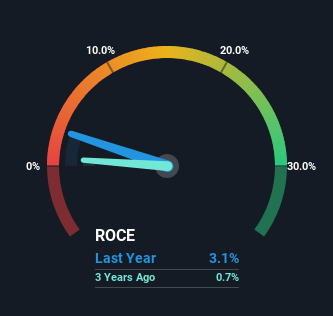
Finding a business that has the potential to grow substantially is not easy, but it is possible if we look at a few key financial metrics. Firstly, we'd want to identify a growing return on capital employed (ROCE) and then alongside that, an ever-increasing base of capital employed. If you see this, it typically means it's a company with a great business model and plenty of profitable reinvestment opportunities. So when we looked at TATSUMI (TSE:7268) and its trend of ROCE, we really liked what we saw.
What Is Return On Capital Employed (ROCE)?
Just to clarify if you're unsure, ROCE is a metric for evaluating how much pre-tax income (in percentage terms) a company earns on the capital invested in its business. Analysts use this formula to calculate it for TATSUMI:
Return on Capital Employed = Earnings Before Interest and Tax (EBIT) ÷ (Total Assets - Current Liabilities)
0.031 = JP¥145m ÷ (JP¥9.1b - JP¥4.5b) (Based on the trailing twelve months to June 2024).
Therefore, TATSUMI has an ROCE of 3.1%. In absolute terms, that's a low return and it also under-performs the Auto Components industry average of 6.2%.
View our latest analysis for TATSUMI

Historical performance is a great place to start when researching a stock so above you can see the gauge for TATSUMI's ROCE against it's prior returns. If you'd like to look at how TATSUMI has performed in the past in other metrics, you can view this free graph of TATSUMI's past earnings, revenue and cash flow.
So How Is TATSUMI's ROCE Trending?
It's great to see that TATSUMI has started to generate some pre-tax earnings from prior investments. Historically the company was generating losses but as we can see from the latest figures referenced above, they're now earning 3.1% on their capital employed. Additionally, the business is utilizing 21% less capital than it was five years ago, and taken at face value, that can mean the company needs less funds at work to get a return. The reduction could indicate that the company is selling some assets, and considering returns are up, they appear to be selling the right ones.
On a side note, we noticed that the improvement in ROCE appears to be partly fueled by an increase in current liabilities. Essentially the business now has suppliers or short-term creditors funding about 49% of its operations, which isn't ideal. And with current liabilities at those levels, that's pretty high.
In Conclusion...
From what we've seen above, TATSUMI has managed to increase it's returns on capital all the while reducing it's capital base. And given the stock has remained rather flat over the last five years, there might be an opportunity here if other metrics are strong. With that in mind, we believe the promising trends warrant this stock for further investigation.
If you want to know some of the risks facing TATSUMI we've found 3 warning signs (1 is significant!) that you should be aware of before investing here.
While TATSUMI isn't earning the highest return, check out this free list of companies that are earning high returns on equity with solid balance sheets.
Valuation is complex, but we're here to simplify it.
Discover if TATSUMI might be undervalued or overvalued with our detailed analysis, featuring fair value estimates, potential risks, dividends, insider trades, and its financial condition.
Access Free AnalysisHave feedback on this article? Concerned about the content? Get in touch with us directly. Alternatively, email editorial-team (at) simplywallst.com.
This article by Simply Wall St is general in nature. We provide commentary based on historical data and analyst forecasts only using an unbiased methodology and our articles are not intended to be financial advice. It does not constitute a recommendation to buy or sell any stock, and does not take account of your objectives, or your financial situation. We aim to bring you long-term focused analysis driven by fundamental data. Note that our analysis may not factor in the latest price-sensitive company announcements or qualitative material. Simply Wall St has no position in any stocks mentioned.
About TSE:7268
TATSUMI
Manufactures and sells precision parts for automobiles, motorcycles, industrial machinery, etc.
Acceptable track record low.
Market Insights
Community Narratives



